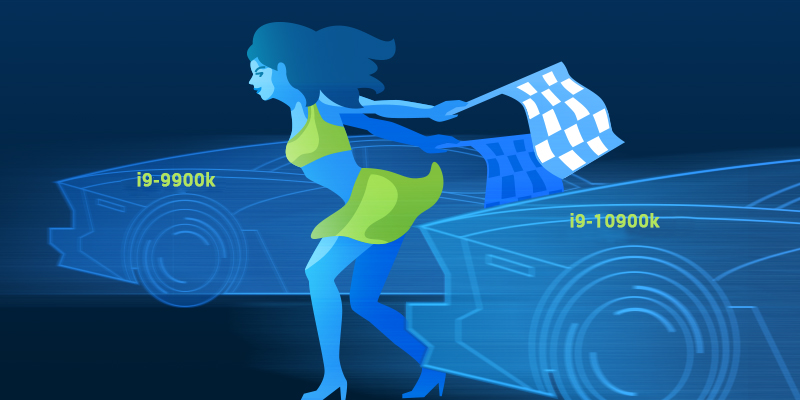
A little over a year has passed since I tested the brand new Intel Core i9-9900K . But time passes, everything changes, and now Intel has released a fresh line of 10th generation Intel Core i9-10900K processors. What surprises these processors are preparing for us and is it really changing - let's talk about it right now.
Comet Lake-S
The codename for the 10th generation Intel Core processors is Comet Lake. And yes, it's still 14 nm. Another refresh of Skylake , which Intel calls "evolution". Their right. Let them call it what they want. In the meantime, we'll see what has changed in the new generation in comparison with the past, the ninth. And let's find out if the i9-10900K has gone far from the i9-9900K. So, we drove the points. Socket
change The
LGA 1151 (Socket H4) socket was developed in 2015 and lasted for 5 years, having seen as many as four generations of processors, which, in general, is not typical of Intel, which likes to change the socket every two years. However, it should be noted that the company more than compensated for this moment with incompatibility between new / old processors and chipsets ...
Yes, nothing lasts forever under the moon, and Intel simultaneously with the release of the 10th generation rolled out a new socket - LGA 1200 (Socket H5). Despite the fact that it is compatible with the mounting holes (75 mm) with existing cooling systems, the ghostly hope that they will not have to be replaced has disappeared after the first preliminary tests. But more on that later.
More cores, higher frequency
Already traditional for Intel way out of the situation with nanometers: if you do not change the technical process , then add cores and raise the frequencies. It worked this time too.
The Intel i9-10900K processor got two cores, respectively, 4 threads in Hyper-threading (HT). As a result, the total number of cores increased to 10, and the number of threads - to 20.
Since the manufacturing process has not changed, the requirements for heat dissipation, or TPD , have changed from 95 W to 125 W - that is, more than 30%. Let me remind you that these are indicators when all cores are operating at the base frequency. Cooling this brazier with air is not easy at all. It is advisable to use a water cooling system (WCO). But there is also a nuance here.
If the base frequency of the new processor rose by only 100 MHz - from 3.6 to 3.7, then with Turboboost it became more and more interesting. If you remember, the i9-9900K in TurboBust is capable of delivering 5 GHz per core (rarely two), 4.8 GHz for two, the rest plow at 4.7 GHz. In the case of the i9-10900K, one core is now running at 5.1-5.2 GHz and all the others at 4.7 GHz. But Intel did not stop there.
In addition to the already familiar Turbo Boost technology, a megasuperturbboost has appeared. It's officially called Thermal Velocity Boost (TVB) . It should be noted that this technology was introduced back in the eighth generation of Intel Core, but only a select few got it. For example, I personally know the i9-9980HK and i9-9880H.
The essence of the technology lies in the fact that at a certain temperature of the processor, the frequency of one or more cores rises above Turboboost. The value of the added frequency depends on how much the processor's operating temperature is below the maximum. The maximum core frequency of a processor with Intel Thermal Velocity Boost technology enabled is reached at an operating temperature of 50 ° C or less. As a result, in TVB mode, the clock speed of one core rises to 5.3 GHz, and the other cores to 4.9 GHz.
Since in the new generation of cores there are two more cores, in a state of maximum auto-overclocking with all types of "boosts" this "stove" releases up to 250 W, and this is already a challenge even for a water cooling system (CBO), especially in a compact case, without a takeout waterblock ...
They talked about the cores, explained about the frequencies, complained about the socket, let's go further. The main changes include a slightly increased L3 cache and a raised frequency of supported RAM - from DDR-2666 to DDR4-2933. That's basically all. Intel has not even updated the integrated graphics core. The amount of RAM has not changed either, the same 128 GB was inherited from the previous generation. That is, as always with refreshes: they threw in cores and frequencies, however, they also changed the socket. There are no more significant changes, at least in terms of servers. I propose to move on to testing and see how the performance of the new generation has changed in comparison with the past.
Testing
Two processors of the Intel Core line are participating in the testing:
- 9th generation i9-9900K
- 10th generation i9-10900k

-
Intel i9-9900K
- : Asus PRIME Q370M-C
- : 16 DDR4-2666 MT/s Kingston (2 .)
- SSD-: 240 Patriot Burst (2 . RAID 1 — , ).
Intel i9-10900K
- : ASUS Pro WS W480-ACE
- : 16 DDR4-2933 MT/s Kingston (2 .)
- SSD-: 240 Patriot Burst 2 RAID 1.
Both configurations use water-cooled single-unit platforms. But there is a nuance ... In order not to lose TVB frequencies and normally "start" Intel i9-10900K, I had to assemble a powerful custom water cooling system (hereinafter CBO) for the platform with the tenth generation Core. This required some effort (and considerable), but such a solution allowed us, at the highest peak loads, to get a stable 4.9 GHz in each core, without crossing the temperature threshold of 68 degrees. Bow to the hero customizers.
Here I will allow myself some digression from the topic and explain that such an approach to business is dictated exclusively by pragmatic considerations. We find technical solutions that maximize performance with minimal rack utilization, while still getting value for money. At the same time, we do not overclock the hardware and use only the functionality that was laid down by the hardware developers. For example, standard overclocking profiles, if the platform has any at all. No manual setting of timings, frequencies, voltages. This allows us to avoid all sorts of surprises. As, in fact, and preliminary testing, which we conduct before handing over the finished solutions in the hands of customers.
It is no coincidence that we always test in single-unit configurations - such testing is quite enough to make sure that the solution found is reliable. As a result, the client receives proven equipment and maximum speed at the lowest price.
Coming back to our i9-10900K, I would like to note that the temperature of none of the compared processors rose above 68 degrees. This means that the solution, with other advantages, also has a good overclocking potential.
Software part: OS CentOS Linux 7 x86_64 (7.8.2003).
Kernel: UEK R5 4.14.35-1902.303.4.1.el7uek.x86_64
Optimizations made relative to standard installation: added kernel launch options elevator = noop selinux = 0
Testing was performed with all Specter, Meltdown and Foreshadow patches backported to this kernel.
Tests that used
1. Sysbench
2. Geekbench
3. Phoronix Test Suite
Detailed description of tests
Geekbench
, . . :
: «». «», .
Sysbench
Sysbench — ( ) : , , . , . : CPU speed events per second — . , .
Phoronix Test Suite
Phoronix Test Suite — . — . : Himeno LAME MP3 Encoding.
, .
, — .
, . . :
- Single-Core Score — .
- Multi-Core Score — .
: «». «», .
Sysbench
Sysbench — ( ) : , , . , . : CPU speed events per second — . , .
Phoronix Test Suite
Phoronix Test Suite — . — . : Himeno LAME MP3 Encoding.
, .
- John the Ripper . Blowfish. .
- Himeno — , .
- 7-Zip Compression — 7-Zip p7zip .
- OpenSSL — , SSL (Secure Sockets Layer) TLS (Transport Layer Security). RSA 4096- OpenSSL.
- Apache Benchmark — , 1 000 000 , 100 .
, — .
- C-Ray CPU . (16 ), 8 1600x1200. .
- Parallel BZIP2 Compression — , ( .tar Linux) BZIP2.
- . LAME MP3 Encoding . .
- . ffmpeg x264 — . .
Test results
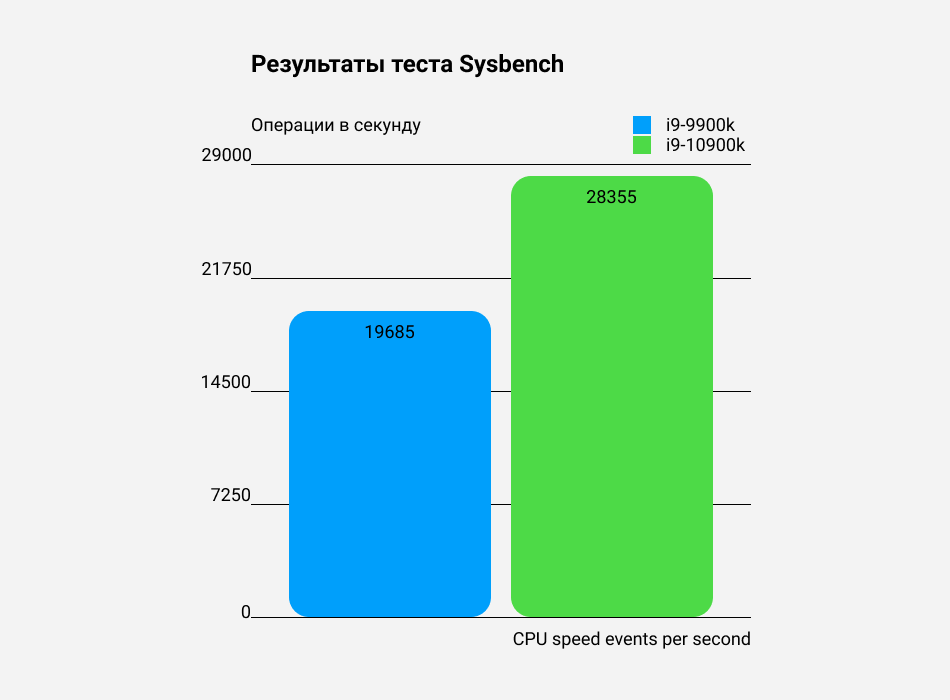
i9-10900K is 44% better than its predecessor . In my opinion, the result is simply gorgeous.

The difference in the single-threaded test is only 6.7% , which is generally expected: the difference between 5 GHz and 5.3 GHz is the same 300 MHz. This is just 6%. And there were some conversations :-)
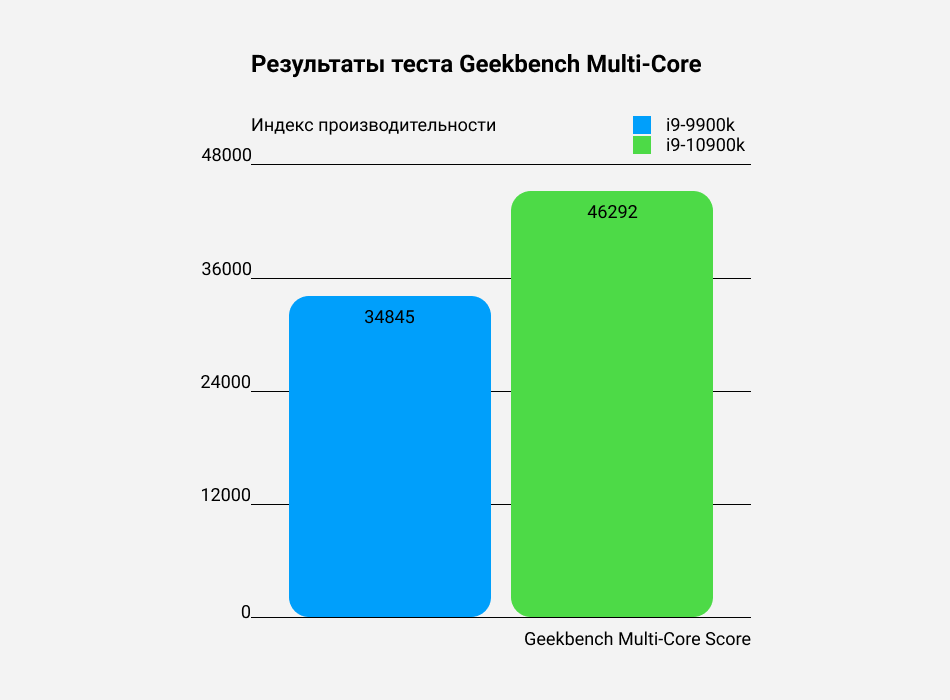
But in the multi-threaded test, the new product has almost 33% more "parrots" . Here TVB played an important role, which we were able to use almost to the maximum with the custom CBO. At its peak, the temperature in the test did not rise above 62 degrees, and the cores worked at 4.9 GHz.

The difference is 52.5% . Just like in the Sysbench and Geekbench multi-threaded tests, such a significant lead is achieved due to CBO and TVB. The temperature of the hottest core is 66 degrees.

In this test, the difference between processors of different generations is 35.7% . And this is the same test that keeps the processor under maximum load 100% of the time, warming it up to 67-68 degrees.
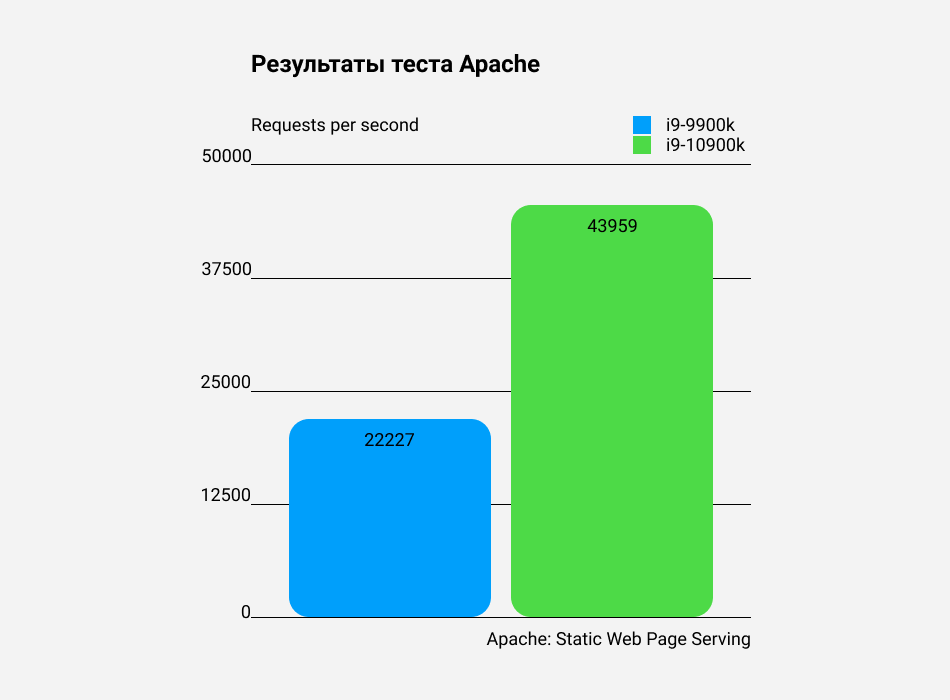
97.8%. The probability of almost two-fold superiority due to 2 cores and a little megahertz is "extremely small". Therefore, the result looks more like an anomaly. I assume that either the test itself is optimized or the processor is optimized. Or maybe both. We will not rely on the results of this test in this case. Although the figure is impressive.

And here I am absolutely sure that optimization was done in the test itself. This is proved by repeated tests of AMD Ryzen, which pass it much better, despite the fact that Ryazan is not so strong in single-threaded tests. Therefore, the 65% advantage will not count. But it was simply impossible not to tell about it. Nevertheless, we write one - we keep two in mind.
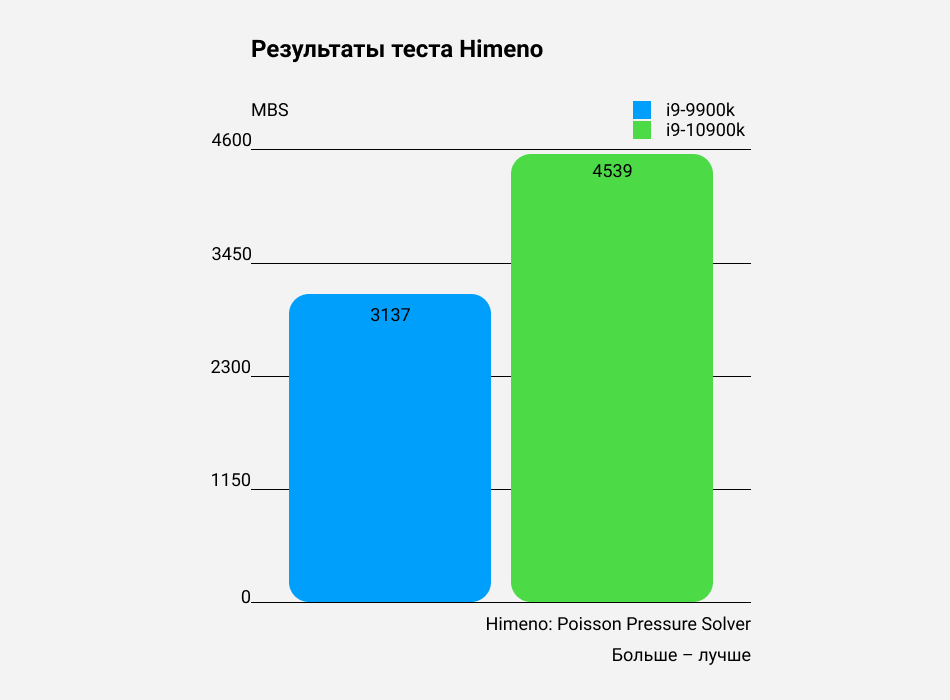
The difference between generations is 44.7%... Everything is fair here, so we count the result. After all, this is exactly the test in which the maximum performance is squeezed out in a single-threaded load. On the one hand, here you can see the work done on the revision and optimization of the kernel - a refresh refresh, but something under the hood was clearly optimized. On the other hand, such results may indicate that we failed to squeeze out the maximum last time in the same test with the i9-9900K. I will be glad to read your thoughts on this in the comments.
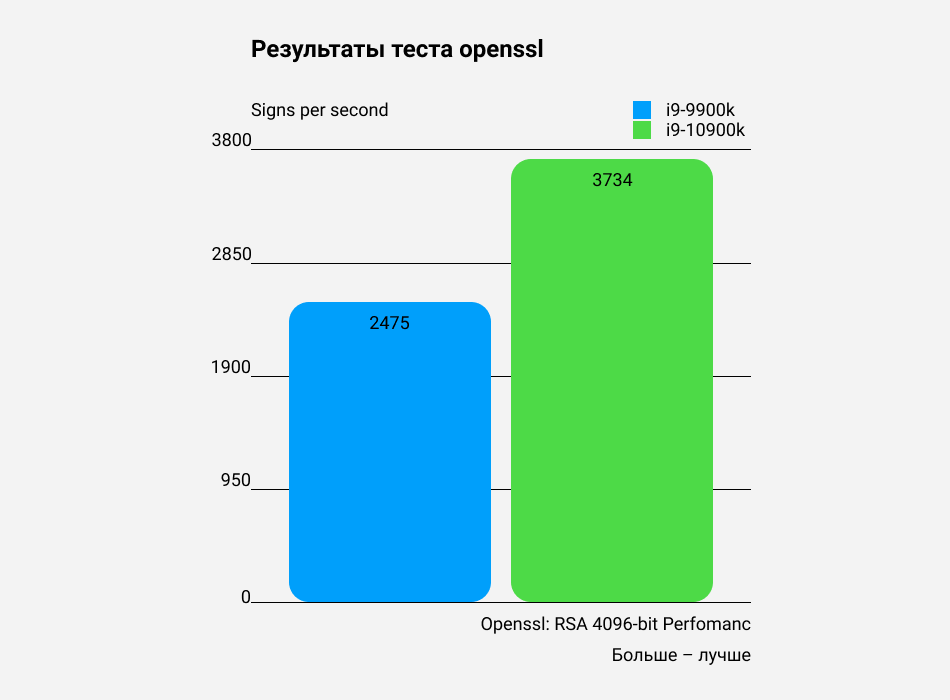
The tenth generation confidently overtakes the ninth by 50.9% . Which is quite expected. Cores and frequencies, added by Intel i9-10900K, rule here.
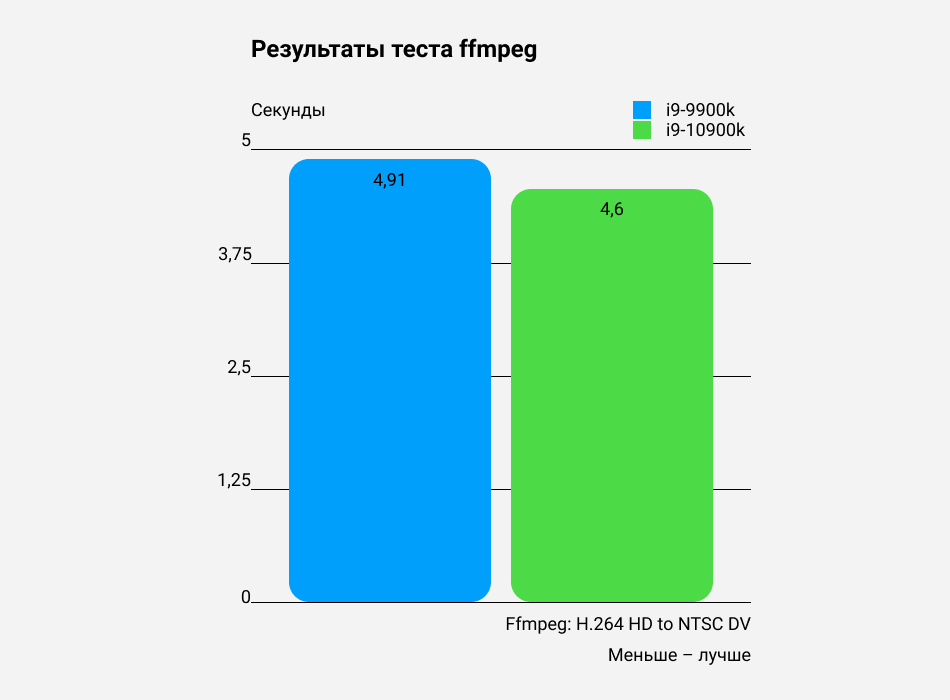
The difference between generations is 6.3%... In my opinion, the result is rather controversial. In future articles, I am considering dropping this test altogether. The fact is that in systems with more than 36 cores (72 threads), the test does not pass at all with standard settings, and the difference in results sometimes has to be counted by the third decimal place. Well, we'll take a look. You can share your opinion on this in the comments.

The difference is 28% . No surprises, anomalies or optimizations were noticed here. Pure refresh and nothing more.
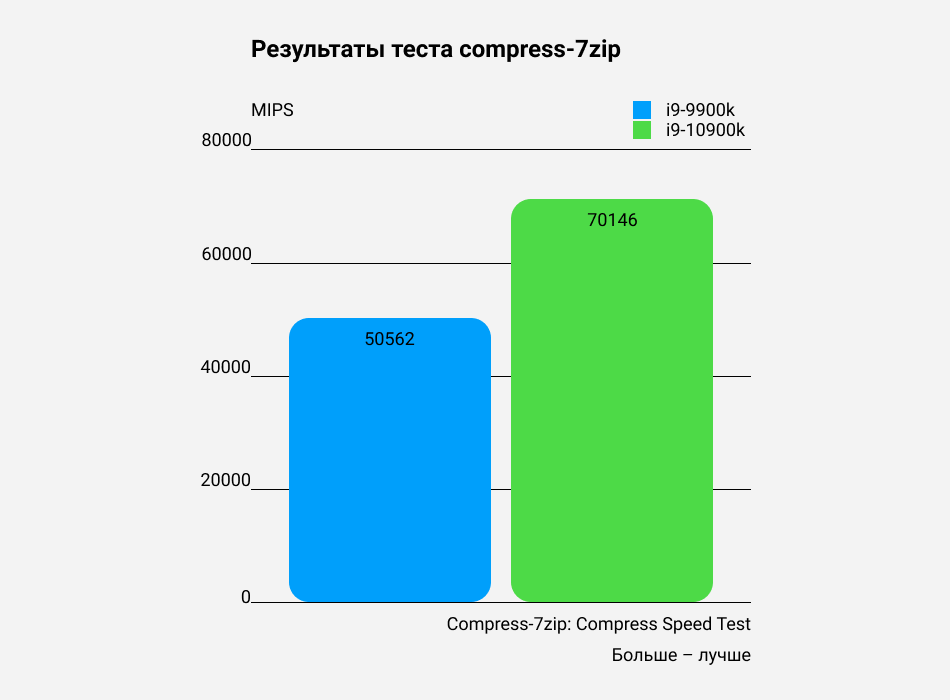
The i9-10900K beats the i9-9900K by 38.7% . As in the case with the results of the previous test, the difference is expected and well shows the real gap between processors on the same microarchitecture.
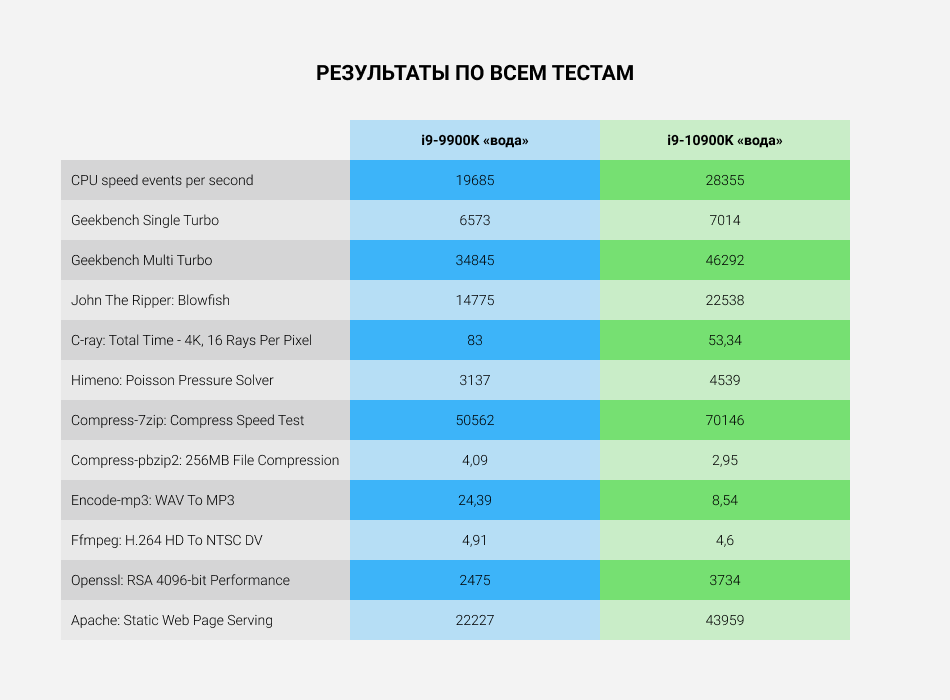
So, let's summarize. In general, nothing unexpected - the i9-10900K beats its predecessor i9-9900K in all tests. Q.E.D. The price for this is heat release. If you are looking for a new processor for home use and are going to squeeze the maximum performance out of the tenth generation Core, I recommend thinking about a cooling system in advance, because some coolers will not be enough here.
Or come to us for Dediks. A ready-made solution on a good platform and with a very decent CBO, which, in addition to all other advantages, as we found out, also has overclocking potential.
In testing we used dedicated 1dedic.ru servers based on Intel Core i9-9900K and i9-10900K processors... Any of them, as well as configurations with the i7-9700K processor, can be ordered with a 7% discount using the INTELHABR promo code . The discount period is equal to the payment period selected when ordering the server. The discount for the promotional code is summed up with the discount for the period. The promo code is valid until December 31, 2020 inclusive.